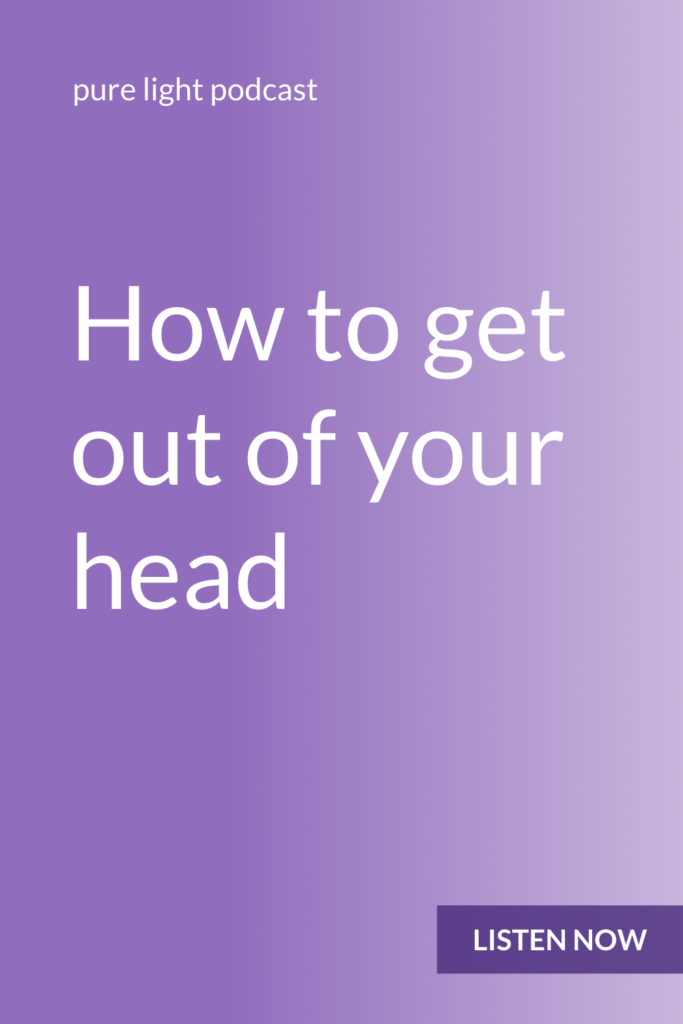Ever find yourself lost in thought?
The moment you notice that your mind has wandered, you’re no longer thinking compulsively.
The breath and body can bring you back into the present moment.
Resources & References
Video: The easiest way to get out of your head
Aili Kuutan: Hello and welcome! You're listening to pure light where we explore how you can believe in yourself and be happy with who you are. My name is Aili. This is episode 13 and it's about what to do when your mind is busy, so how to get out of your head...
Aili Kuutan: And I'm recording this for myself as much as for anyone else right now. I feel like I've been – I've been in my head a lot the last couple of days just with a lot of stuff going on, but not as much as I used to... I used to be in my head pretty much constantly, especially when I was in school. When I was in engineering, I was constantly daydreaming and fantasizing about not being there, and so I feel like I have a lot of experience being in my head and then also starting to find my way out.
Aili Kuutan: So I want to start by talking about how to tell if you're in your head because sometimes that's the hardest thing to notice. It can be challenging to figure out when we're lost in thought because you get so focused on what you're thinking about that it's like you lose touch with the fact that you're not even present.
Aili Kuutan: So here are a couple of signs to tell that you're even stuck in your head. One is you may be smiling and nodding and just saying things like, "yeah," or "mm hmmm," to whoever you're talking with because you aren't really listening to the person or paying attention to them so you don't know what they're saying and you're just kind of pretending to be listening and agreeing and doing that kind of thing. Another sign is you may feel a sense of panic when you realize, "Oh my God, I haven't been paying attention." That's definitely another sign.
Aili Kuutan: Another one is that you may find yourself doing the same thing over and over. So for example, reading and rereading the same paragraph or the same sentence. Or if you're trying to do something, for example, on your computer, you may be kind of like redoing that over and over because you keep getting distracted by whatever's going on in your mind, so there's really no space for you to actually move forward with whatever it is that you're doing or trying to read. Another sign is you may find yourself daydreaming or fantasizing, worrying, wondering about something, planning stuff out, trying to figure out how everything's going to happen or work out, thinking about your to do list, or rehashing something from the past like a conversation or an event or something like that. So any of those could be signs that you are stuck in your head.
Aili Kuutan: And so in terms of how to get out: the moment that you notice that you are doing one of those things, you're no longer thinking compulsively, because when you get stuck in your head, it's like you temporarily lose sight of the fact that you have a choice where to focus your attention. But then the moment that you realize that you are focused on whatever's going on in your head, you have a choice where to refocus so you're no longer distracted by what's going on in your head, but you're able to actually choose, like: Do I want to start listening to this person? Do I want to start reading this paragraph? Do I want to do whatever it is that I'm trying to do beyond that kind of mental processing?
Aili Kuutan: Because at any point in time, each of us only has a limited amount of attention available, so we can focus it on our inner experience — our thoughts, or the images in our minds, or the emotions in the body, any kind of energetic sensations — or we can also focus it on our outer experience — what's going on around us, any external sights and sounds, as well as any physical sensations like contact with the chair that you're sitting on, or like your feet against the floor.
Aili Kuutan: Whenever you realize that you've gotten caught up in your head, the easiest way to bring your attention back to the present moment is to focus on the body. The body is like an anchor and it's always in the present moment, whereas the mind could really be anywhere and so that's why it's really... The easiest way to get out of your head is to bring the mind back into the body and to focus on the body, and the breath is a tool that can help you do that because the breath is ultimately the bridge between the mind and the body.
Aili Kuutan: I think it's important to note there can be like a bit of judgment, a bit of self-judgment, when you do find yourself getting lost in thought because it can seem like it's a problem that that's happening or it's some kind of personal defect. It's not a problem that the mind is wandering. I know it can seem like it's a sign, or it can seem like it's something that shouldn't be happening, especially for example, if you're just getting into meditation, but it's really not a problem because it's an opportunity. It's an opportunity to refocus your attention and be present again.
Aili Kuutan: It's also a moment of awakening because you're conscious of the fact that you're not present, so it's actually a success in a lot of ways when you notice that you're stuck in your head.
Aili Kuutan: If you have anything you'd like to share about this episode, please use the hashtag #purelightpodcast. If you enjoyed this, please share it with someone else.
Aili Kuutan: Thank you so much for listening. Until next time, may you be guided by your light.
Get new episodes by email
Enter your name and email address below and I'll send you periodic updates about the podcast.

